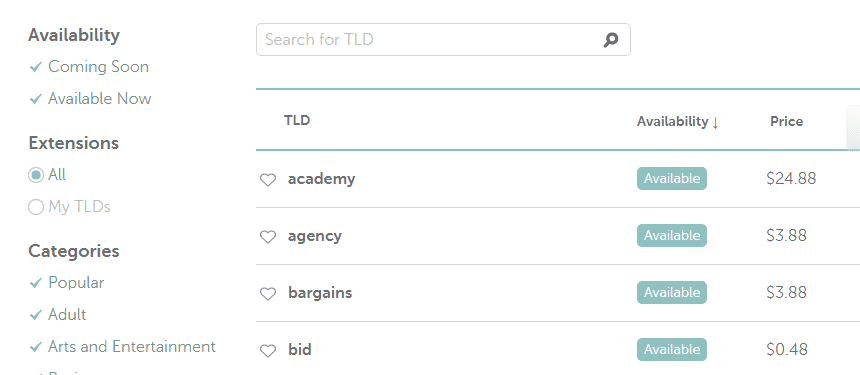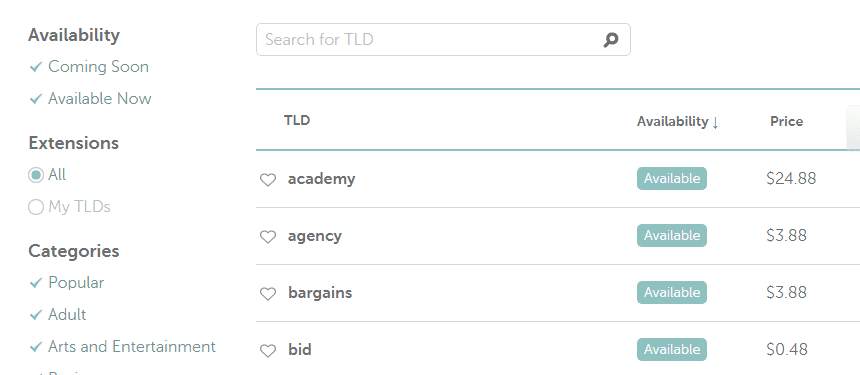When it comes to domains, .com is king. Most people will always opt to use .com domains whenever they can. That brings up the question – can using alternatives to .com impact the way users see your website?
From a technical standpoint, there’s no difference between using a .com domain or any other type. However, using an alternative can impact your site in other ways. In this article, we’ll run through a brief history of domain names and talk about whether you should use a .com URL. Then we’ll introduce you to some other worthwhile alternatives.
Let’s take it from the top!
A Brief History of Top-Level Domains
There are over 1,000 TLDs available and new ones are coming out all the time.
Top Level Domains (TLDs) are the suffixes at the end of every URL. .com is the most well-known TLD, but it’s hardly the only one. In fact, there are over 1,000 TLD options available. Not all of them are available to the public, but that’s still a lot of options.
The name .com comes from the word “commercial” and the first domain name to use it was symbiolics.com, in 1985. Before TLDs, if you wanted to reach a website, you needed to connect to it through its IP address. Each server you connect to still has its own IP address you can reach, but that proved too unwieldy for everyday use. To tackle that problem, the Domain Name System (DNS) launched in 1985.
It’s thanks to the DNS you can connect to your favorite websites using simple-to-remember names. More importantly, keeping a record of registered domains enables us to avoid duplicates. TLDs are an integral part of this system and back when they launched, options were more limited. Aside from .com, 1985 also saw the launch of multiple other TLDs, including staples such as .org, .edu, and .net. Over thirty years later, all those TLDs are still common the web.
The organization that manages new TLDs and handles maintenance for key related databases is the Internet Corporation for Assigned Names and Numbers (ICANN). It was born in 1998, and although the rate of new TLDs was slow in its early days, it rose sharply in recent years. If you’ve registered a domain lately, you’ve probably noticed you have a lot more TLD options than even a few years back. That isn’t necessarily a bad thing, but the problem is, people still prefer good old .com TLDs, which brings us to the next section.
The Pros and Cons of Using a .com Domain
As we mentioned earlier, there’s no technical upside to using a .com domain over any other alternative. For example, imagine you want to register a new domain called puppiesarethebest. Even if you go with puppiesarethebest.com, puppiesarethebest.fun, or even puppiesarethebest.blog, it won’t affect your website’s functionality in any way.
However, we would be remiss if we didn’t point out there are some real benefits to using .com domains. Let’s talk about what they are:
- .com sounds more trustworthy. Non-tech savvy users might not want to use alternatives to .com since that’s the TLD they know and trust the most.
- It can make your website seem more authoritative. In a lot of cases, people will automatically assume .com domains are more serious than other TLDs. That goes double if you use a TLD that sounds ‘gimmicky, such as .fun or .xyz.
- .com is easy to remember. People are accustomed to using .com to visit most of their favorite websites, so they could struggle to remember other TLDs.
To be succinct, even though there’s no technical advantage to using a .com TLD, there are psychological benefits. If the domain you want is available with a .com TLD, it therefore makes sense to use it. This brings us neatly around to the main downside of .com domains, which is availability. Considering their popularity, it can be hard to find the domain name you want since a lot of them are already taken. Some people even buy and ‘squat’ on them as a way to make money.
Fortunately, using alternatives to .com is no longer the kiss of death for a website. There are plenty of TLDs that, while not as popular as .com, are reputable enough for a serious site. We’ll talk about what they are in a minute, but for now, we want to leave you with some quick recommendations for when you register a new domain name:
- Use short, memorable names. We recommend this in most cases, unless you want to go with your own brand name.
- Check your name on social media. See if you can use the same name across all platforms to help create consistent branding.
- Avoid forcing keywords. This is also known as ‘keyword stuffing‘ and is a big no-no.
If you keep these three simple tips in mind, your domain name should be excellent, regardless of which TLD you choose.
5 Alternatives to .com Worth Considering
There might be over a thousand TLDs to choose from, so let’s narrow this down to a few options we think are worth considering. The five options below are not the only good alternatives to .com, but they’re your best bets if you want a domain name that sounds reputable and authoritative.
1. .io
The .io TLD has one of the most interesting stories among them all. Technically, this is a country code TLD, meaning that it’s assigned to a specific geographic region (such as .fr for French domains). This particular TLD was assigned to the British Indian Ocean Territory, hence the .io abbreviation.
Considering its limited scope, the .io TLD should’ve languished in obscurity, like many others. However, the TLD was adopted by the tech community, and it quickly became a darling of startups and several online services. If you want to run a tech website, using a .io domain can impart it a bit of ‘coolness’ factor, which makes it an excellent alternative to .com.
The only downside to this TLD is they tend to be rather expensive. In fact, .io domains often start at around $90 per year.
2. .co
.co is another example of a country-code TLD that was adopted by the rest of the world due to its uniqueness. In this case, the .co TLD corresponds to Colombia. However, the TLD also gained traction due to the fact it’s only one letter removed from .com alternatives.
If you’re looking for a .com domain that’s taken, .co might be a good option. It looks similar and since it’s a short TLD it’s easy to remember. The only downside is .co is so similar to .com, users might confuse them, and visit the wrong website.
As far as prices go, .co domains tend to be a bit cheaper than their .com counterparts. You can often find options below the $10 mark.
3. .net
.net domains have been around for as long as their .com counterparts. While not as popular, this particular TLD has a lot going for it. For one, internet users are accustomed to it and generally see .net domains as being trustworthy.
Technically, .net domains are for organizations that focus on networking technology. However, these days people use .net domains for all kinds of purposes. In our opinion, if you want a domain name that sounds authoritative, .net is a great option when .com isn’t available.
Moreover, .net domains tend to go for the same prices as .com options, starting at around the $10-15 per year range.
4. .blog & .shop
Generally, we’re not big fans of TLDs that sound like gimmicks. However, we’ll be happy to make an exception for .shop and .blog domains.
We’re bundling these TLDs together because they fulfill a similar type of need. That is to say, they’re good options for websites with a specific purpose. Aside from that, they’re easy to remember and they accurately describe the purpose of the site. The best part is since neither of these TLDs is very commonly used, you can get amazing domain names that you probably couldn’t with .com, .net, or .io.
.blog and .shop also tend to be slightly cheaper, with most domain name available below the $10 per year mark.
5. Country Code TLDs
We’ve already talked about two country code TLDs. However, you have plenty more options to choose from beyond .io and .co. Most countries have their own assigned TLDs and some of them are available to users outside their designated region. In some cases, they will be available but you will be forced to jump through some extra hoops before you can register one.
This can be annoying, but it can be worth it to snag excellent and unique domains. You could even use this to target a specific region. When someone sees a TLD from their own country, they might be more inclined to trust it, which gives you an advantage.
As far as prices go, however, country-specific TLDs can vary wildly. That means you’ll need to do some digging of your own to find out how much specific country-code domains go for in your region.
Conclusion
There are hundreds of alternatives to .com to choose from. If the domain you want is available with .com, it’s usually worthy using it, because it’s a safe, reliable, and trusted option. However, if it isn’t available, or if you want something different, you have plenty of TLD options that are easy to remember and have their own unique advantages.
For example, we’ve shown you five of our favorite alternatives to .com domains in this article. These are:
- .io: This is an excellent option for tech websites and startups.
- .co: A popular stand-in for .com when those domains aren’t available.
- .net: As far as seniority and trust goes, .com and .net are neck and neck.
- .blog & .shop: These two up-and-coming TLDs are modern, and they make for excellent and descriptive domain names.
- Country code TLDs: Going local is always an excellent option if you want to snag unique domain names.
What do you think about using other TLDs besides .com? Share your experiences with us in the comments section below!
Article image thumbnail by Turan Ramazanli / shutterstock.com


